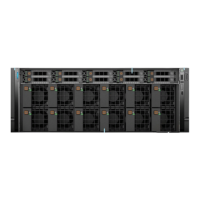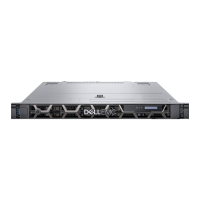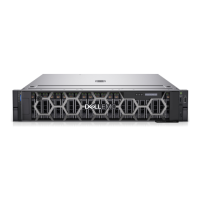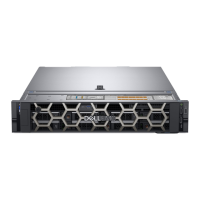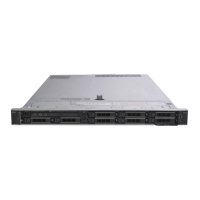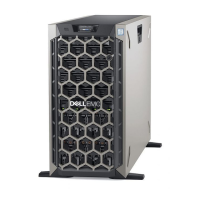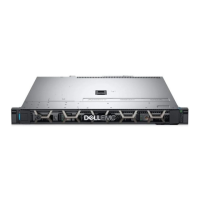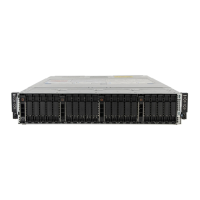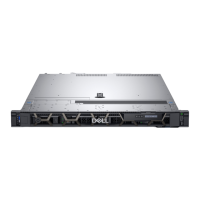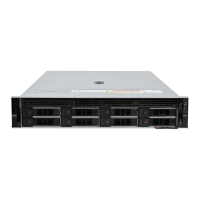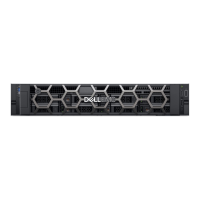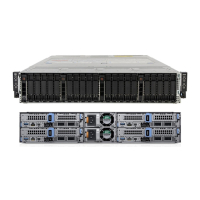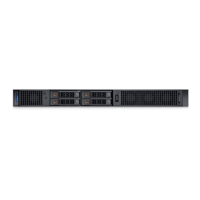
Do you have a question about the Dell EMC PowerEdge XR11 and is the answer not in the manual?
| Form Factor | 1U Rack |
|---|---|
| Max Processors | 2 |
| Management | iDRAC9 |
| Processor | Intel Xeon Scalable processors |
| Memory | DDR4 |
| Storage | NVMe, SAS, SATA |
| Drive Bays | Up to 10 x 2.5" or 4 x 3.5" |
| Storage Controller | PERC H755 |
| Network Interface | 1GbE |
| Network Controller | Intel |
| Power Supply | Redundant Power Supplies |
| Operating System | Windows Server, Linux, VMware |
| Chipset | Intel |
Identifies and describes the components and ports visible on the front of the server.
Explains the status LED indicators and their meaning for system health and identification.
Details the power button, USB port, and iDRAC Direct port on the server's front panel.
Identifies and describes the components and ports visible on the rear of the server.
Provides a visual guide to the internal components of the PowerEdge XR11 server.
Explains how to find the unique Service Tag and Express Service Code for system identification.
Describes the location and information found on the system information label.
Provides information on selecting compatible rail kits for rack mounting the XR11 system.
Outlines the basic steps for unpacking, installing, and powering on the server.
Explains the purpose and basic configuration of the Integrated Dell Remote Access Controller (iDRAC).
Lists resources and documentation links for installing a supported operating system on the server.
Details options for downloading system firmware using various Dell tools and utilities.
Provides instructions on how to download the latest BIOS, drivers, and system management firmware.
Lists the essential components required for the system to complete the Power-On Self-Test (POST).
Explains how the system validates its configuration against qualified configurations during POST.
Details common system error codes (HWC8010, HWC8011) and their potential causes and resolutions.
Essential safety precautions and warnings to follow before, during, and after component installation/removal.
Steps to take to safely prepare the system before performing any internal component maintenance.
Procedures for completing maintenance tasks, including reassembly and powering on the system.
Lists the specific tools required for performing hardware removal and installation procedures.
Instructions for removing and installing the front bezel of the server.
Procedures for removing and installing the bezel filter for the server's front bezel.
Detailed steps for removing and installing the server's system cover.
Step-by-step guide to securely install the server's system cover.
Instructions for removing and installing the PCI air shroud and processor air shroud.
Procedures for removing and installing the server's cooling fans.
Details on removing and installing the intrusion switch module, a service technician replaceable part.
Covers removal and installation of drive blanks, carriers, and drives within the system.
Instructions for removing and installing the drive backplane, a service technician replaceable part.
Table detailing internal storage configurations, chassis, backplane, and controller options.
Illustrates cable routing for NVMe and SAS/SATA connections to the drive backplane.
Provides guidelines for system memory, including channel organization and population rules.
General guidelines for optimal system memory performance and compatibility.
Specific guidelines for installing Intel Optane PMem 200 Series memory modules.
Step-by-step instructions for safely removing a memory module from its socket.
Step-by-step instructions for safely installing a memory module into its socket.
Procedures for removing and installing the processor and its associated heat sink module.
Detailed steps to separate the processor from its heat sink module.
Detailed steps to install the processor into its heat sink module.
Comprehensive guide to installing the processor and heat sink module assembly.
Information on installing and removing expansion cards and their associated risers.
Guidelines for selecting and installing expansion cards based on riser and slot configurations.
Instructions for removing expansion card risers (Riser 1, Riser 2, and Riser 3).
Instructions for installing expansion card risers (Riser 1, Riser 2, and Riser 3).
Steps to remove various expansion cards from their respective risers.
Steps to install expansion cards into their respective risers, including filler brackets.
Information on removing and installing the optional BOSS S1 card.
Instructions for removing the BOSS S1 card from the system board connector.
Instructions for aligning and installing the BOSS S1 card into the system.
Instructions for removing an M.2 SSD module from the BOSS S1 card.
Instructions for installing an M.2 SSD module onto the BOSS S1 card.
Covers the procedure for replacing the system battery.
Step-by-step instructions for safely replacing the system battery.
Instructions for removing and installing an internal USB key.
Instructions for removing the internal USB key from the Riser 1 USB port.
Instructions for connecting and installing the internal USB key onto Riser 1.
Details on PSU features, installation, and removal for the PowerEdge XR11 server.
Explains the hot spare feature for PSU redundancy and power efficiency.
Instructions for removing a power supply unit blank from the PSU bay.
Step-by-step guide to safely remove a power supply unit (PSU) from the server.
Step-by-step guide to safely install a power supply unit (PSU) into the server.
Instructions for removing and installing the Power Interposer Board (PIB).
Instructions for removing the Power Interposer Board (PIB) from the system.
Instructions for installing the Power Interposer Board (PIB) into the system.
Instructions for removing and installing the system board and related procedures.
Detailed steps to safely remove the system board from the chassis.
Detailed steps to safely install the system board into the chassis.
Guides on using the Easy Restore feature to restore system configuration data.
Information on upgrading, removing, installing, and initializing Trusted Platform Modules (TPM).
Prerequisites and steps for upgrading the Trusted Platform Module (TPM).
Instructions for removing the Trusted Platform Module (TPM) from the system board.
Instructions for installing the Trusted Platform Module (TPM) onto the system board.
Steps to initialize the TPM, changing its status to Enabled, Activated.
Steps to remove the status LED control panel assembly from the rear accessed system.
Steps to install the status LED control panel assembly onto the rear accessed system.
Steps to remove the power button control panel assembly from the rear accessed system.
Steps to install the power button control panel assembly onto the rear accessed system.
Steps to remove the status LED control panel from the front accessed system.
Steps to install the status LED control panel onto the front accessed system.
Steps to remove the power button control panel from the front accessed system.
Steps to install the power button control panel onto the front accessed system.
Details the components and installation of the MIL 901E and MIL 461G rugged kit.
Instructions for installing the MIL 901E and MIL 461G rugged kit components.
Identifies and describes the connectors on the system board.
Details the settings and functions of system board jumpers.
Procedure for disabling system and setup passwords using the system board jumper.
Explains the status LED indicators on the front panel and their meaning.
Describes the system health and system ID indicator and its operational codes.
Explains the iDRAC Direct LED indicator codes for connection status.
Explains the NIC indicator codes for network activity and link status.
Details the indicator codes for AC and DC power supply units (PSUs).
Explains the drive indicator codes on the drive carrier for drive status.
Guides on running system diagnostics for hardware testing and issue resolution.
Information on how to dispose of system components and recycling services.
Provides information on how to contact Dell support for sales, assistance, or service.
Explains how to use the Quick Resource Locator (QRL) to access system information.
Details how to use the QR code to access online resources for the XR11 system.
Explains the benefits of Dell EMC SupportAssist for automated technical support.
